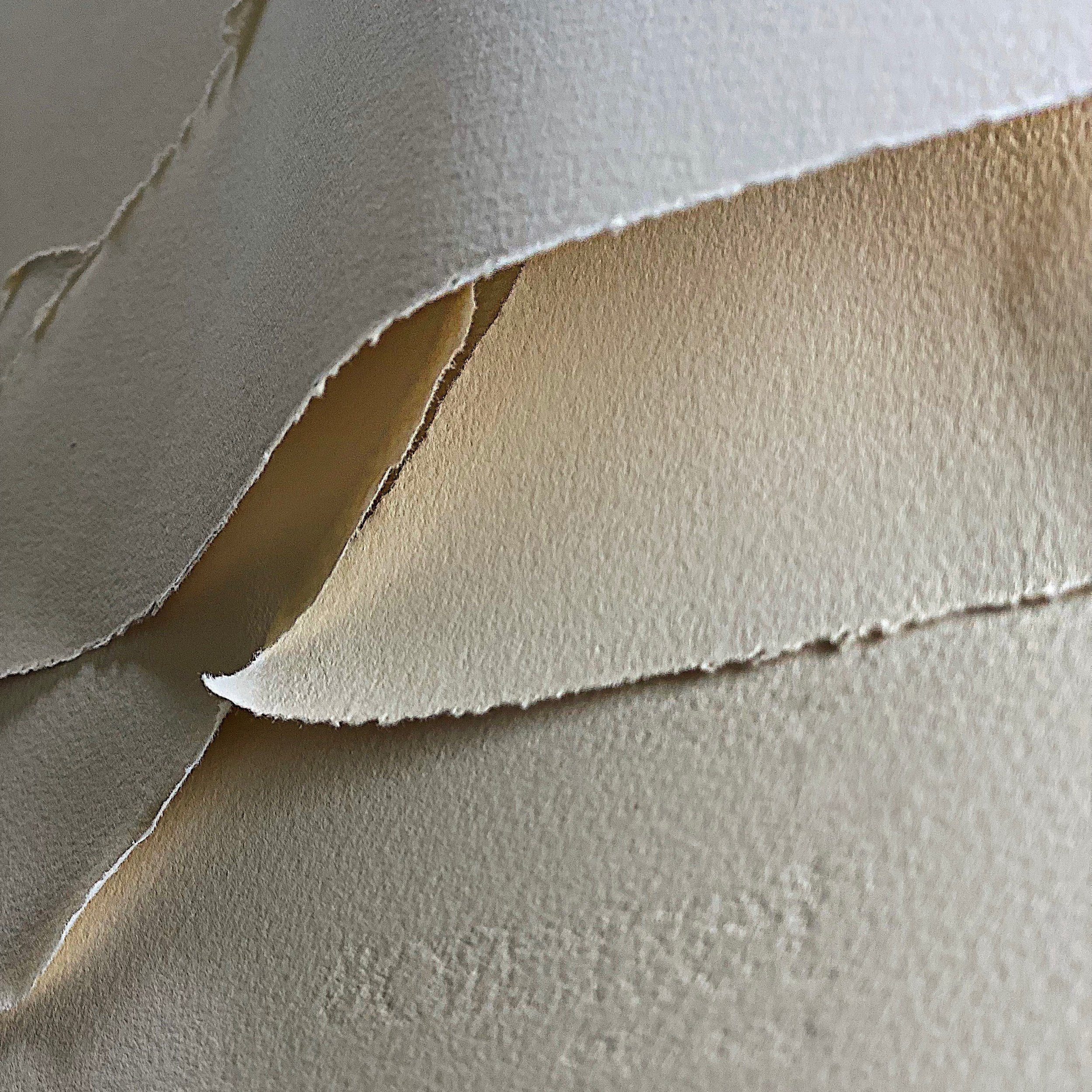
St Cuthberts Mill are experts in making archival grade papers that are designed to last. The papermakers at the mill are skilled craftsmen, who take great pride in producing consistent high-quality papers. Every different batch of paper has undergone rigorous testing by their experts to ensure the quality of the paper is guaranteed. As part of their archival assurance, every sheet receives a calcium carbonate buffering to help defend finished works from discolouration caused by acids present in the atmosphere. The shades of the sheets are all designed to be lightfast, that won’t change over time.
The papers made at St Cuthberts Mill are beautiful! Highly tactile, as well as functional for artists’ techniques. The papers all have the distinctive weave created by genuine woollen felts that are pressed into the sheets to get a random surface texture, which shows through into the finished piece of work with watermedia and printmaking techniques.
All fibres used in papermaking at St Cuthberts Mill are carefully sourced, to ensure they are grown responsibly and from sustainable sources, in addition to being of high enough standard, to guarantee their papers will be archival and clean from debris. The mill works in harmony with the natural environment surrounding them, and successfully ensures that their papermaking does not adversely affect their local surrounding. St Cuthberts Mill are experts in recycling any paper that isn’t up to their high standards, successfully turning it into new paper.
The History of St Cuthberts Mill
St Cuthberts Mill is situated in the southwest of England in the beautiful county of Somerset, just outside the Cathedral City of Wells on the foothills of the Mendip Hills. It is the pure waters of the River Axe that feed the mill being the lifeblood of St Cuthberts Mill. The Mendips are made of limestone which naturally filter the water through miles of glorious cave systems, before the River Axe rises at the cave mouth of Wookey Hole, which is only a mile upstream from St Cuthberts Mill.
The mill has been making paper since the 1700s taking advantage of the pure waters of the River Axe. The buildings are extremely grand and exude the history that has lived amongst its walls. St Cuthberts Mill is known as the ‘Buckingham Palace’ of papermills, with its impressive Victorian frontage, landscaped gardens and impressive lion sculptures adorning the roof, surveying the grounds below.
The History of Paper and the Paper Making Process
Papermaking is an old technology, with it first being invented 100 BC in China, where it was a carefully guarded secret. The secret eventually made it to Europe in 1036 when Spain started making paper, followed by Italy a couple of hundred years later, with the technology moving through Germany, Holland and finally coming to England 500 years later in 1495.
There are three ways to make paper: handmade, mould made and Fourdrinier made. With handmade paper the papermaker dips a hand mould and deckle into a vat of pulp to create individual sheets, with Fourdrinier made paper the pulp mixture is squirted onto a continuously moving wire belt. This process makes paper very quickly, with most papers being made in this manner, as it is a cheaper and faster way to make paper. Unfortunately, the fibres inside Fourdrinier made sheets predominately align themselves in one direction, which makes the paper less dimensionally stable when water is added to the paper. If a paper doesn’t state how it is made, it is safe to assume it is Fourdrinier made.
St Cuthberts Mill uses a special process to make paper called ‘mould made’ which is much rarer. It involves their skilled papermakers using a ‘cylinder mould machine’ to produce their world-renowned papers. This is a type of mechanised hand-made process, where the fibres inside the paper are more randomly placed than the standard Fourdrinier made papers. A slowly moving cylinder rotates inside a vat of pulp and slowly forms the paper with every revolution of the cylinder. Importantly, because the fibres are more randomly placed inside the sheet, the paper remains flatter once the artist applies water to the paper, giving it the necessary resistance to buckling and curling that is important for artists.
Artists demand a lot from their paper and creating paper to suit the needs of artists requires skilled craftsmen.

“We at St Cuthberts Mill are particularly proud to showcase our brands featuring Saunders Waterford, Somerset and Bockingford via such celebrated retailers as Green & Stone, whose reputation and expertise in the fine art market is unrivalled. It is our privilege after 300 years of papermaking to work together in supplying and advising discerning artists in the promotion of their craft.”
— Alan Walker, Chairman of St Cuthberts Mill
St Cuthberts Mill Paper
-
Bockingford is a very hardworking watercolour paper. It is unsual for a wood-based paper to be mould made, with all the powerful quality engineering of a top-level paper, but at a lower cost, making it quite unique. St Cuthberts Mill have created a very attractive looking paper, created with woollen felts, to give a lovely random surface texture on both sides, allowing both sides of the sheet to be used.
Famed for its versatility and forgiving nature, along with its superb colour lifting abilities, where pigment can be cleanly removed back to the whiteness of the sheet. Bockingford retains a good colour intensity, plus is suitable for multiple glazes, and can be trusted that the surface will not break down and bobble. The paper remains wet for a good period of time, so the artist has a good time to work on the painting. The textures an artist can achieve on Bockingford are magnificent, harnessing the power of back runs, to create superb effects in the wash.
There are no animal products in Bockingford’s recipe. The ‘wood-free’ pulps are selected from European managed forests, where the trees are in a constant cycle of plantation, growth and harvesting in synergy with the natural lifecycle of the trees. The fibres are carefully sourced to have a high amount of alpha cellulose to ensure Bockingford is archival.
Bockingford is unsual that it also comes in five different shades, along with the white sheet, which is a good clean bright white. All the colours are lightfast, with no OBA. Using one of the five coloured tints (cream, blue, eggshell, grey and cream) as a watercolour paper will instantly add atmosphere and change the temperature of the finished composition, as the translucent watercolour pigments are affected by the base colour of the sheet.
Bockingford is a paper whose performance can be trusted and suitable for professional grade work.
-
Saunders Waterford is an exquisite high quality professional watercolour paper. This is the superior paper made by St Cuthberts Mill and endorsed by the Royal Watercolour Society. A very elegant looking paper with four deckle edges, a very attractive surface and mould made from luxurious 100% cotton to archival standards. For authenticity, it bears a watermark with the ‘Saunders Waterford’ name, and an embossed emblem of the St Cuthberts Mill cross. Its surface is coated in gelatine to give the paper great strength, which will withstand rough treatment.
The paper paints beautifully with smooth washes, producing large flat areas of colour, that remains wet for a long period of time giving artists an extended period in which to work. Colours blend beautifully and remain bright with excellent colour intensity. The paper will take multiple glazes of colour.
Available in two shades of white, the traditional creamy ‘White’ shade for warmer tone paintings, and a ‘High White’ (with no OBA) which gives a cooler, but more vibrant contemporary look to finished work.
-
Millford is an unusual paper, as it is deliberately made to be ‘hard sized’. In laymen’s terms this means the paper stays in a wetter state for longer, giving more time to move and blend pigment on the sheet. The washes dry evenly in a controlled manner and paints smooth areas of colour beautifully. Millford will take multiple glazes, with colours retaining their glow and having excellent vibrancy. Lifting colour techniques are successful with Millford to bring back the white of the sheet, without the sheet breaking down and bobbling.
The paper is mould made by St Cuthberts Mill to archival standards. It is made with luxurious cotton and has an attractive surface texture created with genuine woollen felts. The cotton linters inside St Cuthberts Mill papers are sourced responsibly and are a by-product of the textile industry. There are no animal products inside Millford.
-
Somerset is a very diligent printmaking paper made by the experts at St Cuthberts Mill. Designed to suit multiple printmaking techniques including intaglio (including etching), relief (including lino printing), stone lithography and silkscreen printing. A very good-looking paper, with a gentle texture, Somerset has a soft tactile feel, yet is strong enough to ensure excellent printing, withstanding the pull of a plate without picking. The texture is created with natural woollen felts and has four exquisite deckle edges and two watermarks bearing the ‘Somerset’ name.
The paper is mould made from luxurious cotton giving a very stable sheet suitable for multi-colour printing due to its excellent print registration. Somerset enables bright saturated colours to be printed.
Cotton is a docile fibre making Somerset pliable when damp, and perfect for picking up fine detail. There is a depth to the sheet giving a lovely ‘squash’ for artists embossing the paper, using letterpress or printing from an etching plate.
Every batch of Somerset is known for its excellent consistency and archival qualities, a must for printmakers running editions.

As part of Works on Paper, and thanks to St Cuthberts Mill’s generous sponsorship, Green & Stone shop are offering a 10% discount on all St Cuthberts Mill Papers, redeemable in the shop or by mail order only.
Get in touch with St Cuthberts Mill
Phone
+44 (0)1749 672015
Website
www.stcuthbertsmill.com
Location
St Cuthberts Mill Limited
Wells, Somerset
BA5 1AG England





